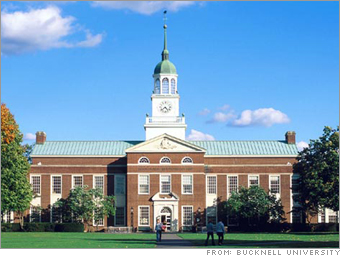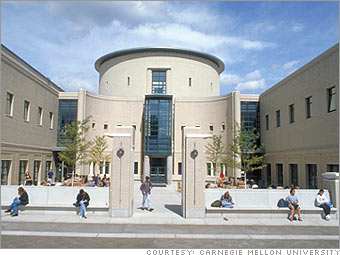Resources:

Tuesday, August 31, 2010
New York University
NYU, founded in 1831, is a private, comprehensive university. Programs are offered through the College of Arts and Sciences; the Schools of Education, Health, Nursing, and Arts Professions; Social Work; and Continuing Education; the Stern School of Business; Tisch School of the Arts; Gallatin School of Individualized Study. Its campus is located in Greenwich Village, New York City. New York University, a member of the distinguished Association of American Universities, is the largest private university in the United States, with a student population of over 38,000 and fourteen schools and divisions. NYU offers over 150 undergraduate majors, including individualized studies. There are also opportunities for double majors, minors, dual degrees, and internships. NYU's main campus is situated in Greenwich Village, New York City. It has study abroad sites in the Czech Republic, England, France, Ghana, Italy, and Spain, among many others, and one of the largest contingents of international students in the US.
Vassar College
Vassar is a private, liberal arts college. Founded for women in 1861, it adopted coeducation in 1969. Its 1,000-acre campus is located on the outskirts of Poughkeepsie, 75 miles north of New York City. It includes a range of architecture from Gothic to modernist. Multidisciplinary studies have been a distinctive feature of academic life at Vassar for more than three decades, fostering an intellectual environment that thrives on crossing disciplinary boundaries and challenging prevailing models of truth. The free exchange of ideas across disciplines stimulates the development of new courses, programs, and resources. Recently, for example, five professors from the departments of biology, psychology, and computer science collaborated to create Vassar's new Interdisciplinary Robotics Research Laboratory, where students and faculty carry out investigations with physical robots as well as computer simulations of virtual robots to further our understanding of complex systems.
Resources:
Swarthmore College
Swarthmore, founded in 1864, is a private, liberal arts college. Its 357-acre campus is located in Swarthmore,10 miles from downtown Philadelphia. Swarthmore is a highly selective college of liberal arts and engineering, located near Philadelphia and enrolling a student body of approximately 1,500. Located on a 357-acre, nationally registered arboretum, Swarthmore is truly a college like no other. Swarthmore is private, yet open to all regardless of financial need; American, yet decidedly global in outlook and diversity, drawing students from around the world and all 50 states; small, yet with the financial strength to offer students and faculty generous resources to push their own and the world's understanding of disciplines from Arabic to plasma physics, from microbiology to dance, from engineering to art history. An institution that celebrates the life of the mind, Swarthmore gives students of uncommon intellectual ability the knowledge, insight, skills, and experience to become leaders for the common good.
Resources:
Resources:
Sunday, August 29, 2010
Boston University
Boston University, founded in 1839, is a private institution. Programs are offered through the Colleges of Communication and Engineering; Metropolitan College - School of Hospitality Management; the Schools for the Arts, Education, Law, Management, Medicine, Public Health, Social Work, and Theology; the Sargent College of Health and Rehabilitation Sciences; the Goldman School of Dental Medicine; and the Graduate School of Arts and Sciences. Its 133-acre campus is located on the Charles River in downtown Boston. Boston University emphasizes student teacher interaction, research and sound education throughout nearly 250 programs of study. With 11 undergraduate Schools and Colleges, the University provides access to myriad internships, one of the nations most extensive study abroad programs, cutting edge research and noted faculty - including three Nobel Laureates, 10 Fulbright Scholars, 3 MacArthur Genius Award recipients and a former Poet Laureate. Students participate in nearly 400 student organizations and 23 NCAA Division I varsity sports teams. The campus continues to expand. New facilities include a new arena, a fitness and recreation center, and a life science and engineering facility.
Resources:
Bucknell University
Bucknell, founded in 1846, is a private university. Its 393-acre campus is located in Lewisburg, 55 miles from Harrisburg. Buildings on campus and in town retain 19th century architectural styles. Bucknell, a national liberal arts university with 3,450 undergraduates and 150 graduate students, combines the personal experience of an intimate liberal arts college and the wide choices offered by a larger university. Our Arts and Sciences and Engineering Colleges offer 53 majors and 65 minors. Bucknell students gain exceptional first-hand experience by collaborating with faculty on research projects. Our Division I Patriot League athletics program is nationally known for its excellent graduation rate and Academic All-American record. Over 150 student organizations complement the academic experience. Together, these opportunities enable students to learn to think critically and to develop leadership skills so that they are prepared to make a difference locally, nationally, and globally.
Resources:
Saturday, August 28, 2010
Colgate University
Colgate, founded in 1819, is a private, liberal arts university. Its 550-acre campus is located in Hamilton, 38 miles southeast of Syracuse. Campus architecture includes 19th- and early 20th-century buildings as well as contemporary structures. As a residential liberal arts college, Colgate provides students with opportunities inside and outside the classroom to imagine their futures and develop as individuals and citizens. A core of four general education courses provides students with an understanding of the foundations of Western thought, an introduction to a non-Western culture, (Asia, Africa or the Americas), and an exploration of the way science and technology shape the world. The college offers more than twenty semester-long programs of study away from campus with a member of the faculty, and a growing array of service-learning opportunities that complement study in 51 academic concentrations.
Resources:
Resources:
Johns Hopkins University
 The first major research university to be founded in America, Johns Hopkins is committed to a fundamental principle education for undergraduates and graduates must be firmly grounded in research and discovery. In this spirit, Hopkins students have pursued a path of exploration, creation, and invention ever since its founding in 1876; currently over 70% of undergraduates conduct meaningful research here, either independently or under the guidance of world-renowned faculty.Students not only build a classical foundation of knowledge in their studies, they learn directly from the cutting-edge work being conducted on campus and in the field. Critical thinking, problem solving, creativity, and entrepreneurship are all fostered and nourished in this unique educational environment. With approximately 4000 undergraduates on campus, Hopkins provides unparalleled opportunities for students to become involved in projects and to receive an extraordinary amount of personal attention. Indeed, students at Hopkins have the freedom to create their own paths. They are supported in their objectives by faculty and staff who recognize students as colleagues and important contributors to the academic community that is The Johns Hopkins University.
The first major research university to be founded in America, Johns Hopkins is committed to a fundamental principle education for undergraduates and graduates must be firmly grounded in research and discovery. In this spirit, Hopkins students have pursued a path of exploration, creation, and invention ever since its founding in 1876; currently over 70% of undergraduates conduct meaningful research here, either independently or under the guidance of world-renowned faculty.Students not only build a classical foundation of knowledge in their studies, they learn directly from the cutting-edge work being conducted on campus and in the field. Critical thinking, problem solving, creativity, and entrepreneurship are all fostered and nourished in this unique educational environment. With approximately 4000 undergraduates on campus, Hopkins provides unparalleled opportunities for students to become involved in projects and to receive an extraordinary amount of personal attention. Indeed, students at Hopkins have the freedom to create their own paths. They are supported in their objectives by faculty and staff who recognize students as colleagues and important contributors to the academic community that is The Johns Hopkins University.Resources:
Carnegie Mellon
Carnegie Mellon, founded in 1900, is a private university. Programs are offered through the Carnegie Institute of Technology; the Colleges of Fine Arts and Humanities and Social Sciences; the Mellon College of Science; and the Schools of Business Administration and Computer Science. Its 103-acre campus is located five miles from downtown Pittsburgh.Carnegie Mellon is a private research university with a distinctive mix of programs in computer science, robotics, engineering, the sciences, business, public policy, fine arts and the humanities. More than 10,000 students receive an education focused on solving real-world problems, interdisciplinary collaboration and innovation. A small student-to-faculty ratio allows for close interaction between students and professors. While technology is pervasive on its 140-acre campus, Carnegie Mellon is also world-renowned for its fine arts programs. It has campuses in California and Qatar, offers programs in Australia, Greece, Singapore and Japan and is expanding its presence in other areas throughout Europe and Asia.
Resources:
Resources:
Subscribe to:
Posts (Atom)





